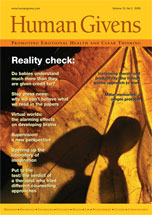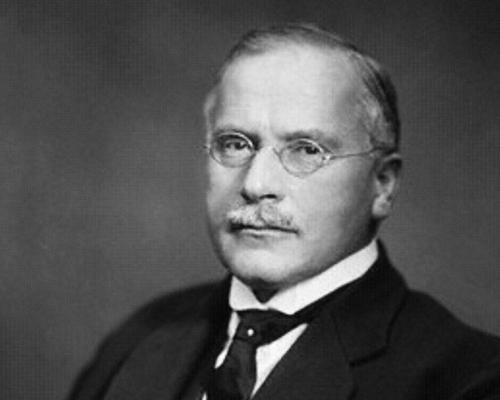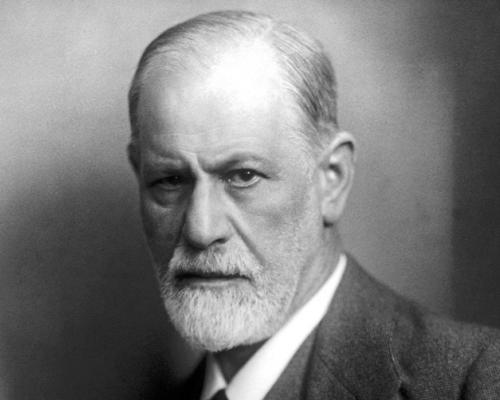The Emotional Needs Scale
Brett Culham describes the outcome of his research to validate the needs-based human givens approach to psychological health.
The organising idea that defines the human givens approach is that universal human needs exist and that, if these needs are not met (through correct use of innate resources), psychological stress and distress ensue.[1] This is a powerful idea that drives an effective approach to therapy but it has not till now been shown, in a way that would satisfy academic researchers, that fulfilment of the stated innate needs is a valid measure of mental health.
Speculation about the psychological needs of humans has a long history but, until relatively recently, had rather fallen by the wayside. In 1908, psychologist William McDougall claimed that certain behavioural tendencies were innate, rather than learned, including curiosity, self-assertion and gregariousness;[2] Sigmund Freud famously believed that sexual satisfaction and aggression were driving human needs, which were largely in conflict with the mores of society, resulting in a further major motivating need – the reduction of anxiety caused by the conflicts.[3] In the 1950s, Abraham Maslow classified needs in a hierarchy, from the basic physiological variety (water, food and sex), through needs for safety, belonging and esteem to self-actualisation (self-fulfilment and insight); in his view, needs lower on the hierarchy would take precedence until fulfilled.[4] In between, in the late 1930s, came psychologist Henry Murray, who developed a list of in excess of 20 needs. This list, along with autonomy, curiosity, affiliation and nurturance, also includ- ed the acceptance of blame and punishment, the enjoyment of pain and misfortune, admiring and yielding to a superior person and making things clean and tidy.[5] His definition of needs was so broad that the concept became seen as in great danger of leading to longer and longer lists of dubious utility. This stalled interest in psychological needs, which were becoming widely employed in motivational psychology at the time. The rise of cognitive psychology, based on thinking strategies, also helped put theories of instinctive needs out of favour.[6]
However, over the past few decades, there has been renewed academic interest in psychological needs, principally through self-determination theory (SDT), which has evolved over the past 30 years through psychological research carried out by Edward Deci and Richard Ryan, professors of psychology at the University of Rochester in New York. As might be expected with a theory developed in a university, SDT is a theoretically driven model, and it has been thoroughly researched and tested in a variety of areas, such as education, healthcare, parenting, industry, sport and exercise, and mental health.[7]
Academia-speak apart, it is clear from the following description that SDT and the human givens approach have much in common. SDT is "a macro-theory of human motivation concerned with the development and functioning of personality within social contexts. It is based on an organismic-dialectical meta-theory, which begins with the assumption that people are active organisms, with innate tendencies toward psychological growth and development, who strive to master ongoing challenges and to integrate their experiences into a coherent sense of self. This natural human tendency does not operate automatically, however, but instead requires ongoing nutriments and supports from the social environment in order to function effectively. That is, the social context can either support or thwart the natural tendencies toward active engagement and psychological growth.
"Within SDT, the nutriments for healthy development and functioning are specified using the concept of basic psychological needs, which are innate, universal, and essential for health and well-being. That is, basic psychological needs are a natural aspect of human beings that apply to all people, regardless of gender, group, or culture. To the extent that the needs are ongoingly satisfied people will function effectively and develop in a healthy way, but to the extent that they are thwarted, people will show evidence of ill-being and non-optimal functioning. The darker sides of human behavior and experience are understood in terms of basic needs having been thwarted."[8]
In the human givens approach, human emotional needs are regarded as expressions of genetically programmed innate knowledge. The biological templates interact in a state of continuous ebb and flow, instinctively seeking fulfilment in the environment, with emotions driving action. Nine psychological needs are proposed that humans naturally seek to fulfil, to accomplish the necessary conditions for nourishment, growth, integrity, and wellbeing: security, giving and receiving attention, connection with a wider community, an intimate close relationship to at least one other person, autonomy, a degree of status within family and peer groups, competence, access to privacy, and meaning. So, if someone lacks intimacy, for instance, that in-complete innate pattern drives the person to seek to make a friend.[9]
The human givens needs model, in principle at least, fulfils the criterion for a valid needs model: that need satisfaction should be predictive of wellbeing.[10] Some previous theoretical approaches have not incorporated this idea and have postulated needs that may actually be damaging to psychological health, such as Murray's proposed needs for abasement and aggression. As the human givens model also proposes a dynamic interaction between the biological templates driving needs, it avoids the rigidity that has dogged hierarchical models such as Maslow's, which are confounded by ample examples of needs higher in the hierarchy taking precedence over needs lower in the hierarchy.
From the human givens perspective, mental health is perceived to exist on a continuum where increasingly poor need fulfilment will lead to dissatisfaction, stress, and mental health problems respectively. If needs aren't met, it can readily be conceived how a state of high emotional arousal and stress would ensue. For instance, someone who has little autonomy in their job might well be stressed, but there would be nothing overtly stressful that might, to the onlooker, account for that person's psychological state. The Perceived Stress Scale, which we will be returning to later, has, indeed, shown that perceived stress correlates only weakly with obviously stressful events, suggesting that other factors are of greater significance.[11]
Preliminary research has shown the human givens approach to be an effective brief therapy — bringing about significant change in an average of 3.6 sessions.[12] The approach also has substantial anecdotal support for its efficacy, with applications extending to psychiatric disorders, youth offending, and education.[13]
The Emotional Needs Audit
Using the nine-needs model, the Human Givens Institute has produced the Emotional Needs Audit (ENA), an 11-item scale measuring emotional need fulfilment. This is used by many therapists, teachers and GPs interested in the human givens approach and is also the basis for an online project designed to find out how well innate emotional needs are being met in the UK.[14] The fact that the human givens approach has been found effective [12] suggests the validity of the nine needs as a practical construct. However, published reliability and validity information on the needs as a measure of psychological wellbeing that would satisfy academics is lacking. If, as is commonly the case, the ENA is used as a starting point for exploration and discussion, the broad nature of the questions will be fit for purpose. But if it is to be used as a measure of psychological health, then thorough scale development is necessary.
Clearly, it would be useful to have objective evidence that fulfilment of the nine needs that are the focus in the human givens approach is, indeed, indicative of psychological health and that lack of fulfilment is indicative of stress. However, since Henry Murray came up with his dubious list of 20 needs, academic researchers in this field have striven to reduce need constructs to the minimum. The SDT reduces basic human needs down to just three: autonomy, competence and relatedness: autonomy is defined as the desire to self-organise behaviour and experience; competence means having an impact on and attaining valued outcomes; relatedness is the desire to feel connected to others, to give love and care and be loved and cared for.[6] This 'reducing down' approach may be useful academically but is less so clinically. There is a danger that the more needs are reduced down, the less useful the information garnered. The human givens need constructs, on the other hand, were developed from the perspective of psychosocial interventions, allowing greater detail that could be more useful in practice than more reductionist measures.
However, it is on the SDT's reduced-down three basic needs that all the research has been done. Fulfilment of these needs has been shown to contribute significantly to psychological health in the workplace [15],[16] and general health practices,[17] and the validity of the construct has been demonstrated across the life span,[18] in both Eastern and Western cultures,[10] between different people, and in the same people over time.[19] Both the human givens and SDT needs models claim to offer holistic measures of need fulfilment. If the needs measured in the human givens model can be substantiated and a scale measuring these needs' fulfilment developed, it could be tested against measures based on SDT, and thus yield meaningful results about both validity and clinical usefulness. This, therefore, is what I set out to do in my research.
Nine into three (almost)
The needs for autonomy, competence, and relatedness are well established by SDT. This clearly substantiates the inclusion of autonomy and competence in the human givens list of needs. It also substantiates inclusion of the needs for intimacy, community, and attention, which can be seen to sit within SDT's notion of relatedness. Privacy has received little attention within the psychological needs literature. How privacy is conceived of is important: if, as has been suggested, privacy is not so much about removing oneself from contact with others but controlling the amount of contact,[20] it may be considered an aspect of relatedness. Having time alone, if it is not chosen, is not going to contribute to psychological wellbeing — lonely people have plenty of privacy but it is not functional for them. The functionally important aspect of privacy from the human givens perspective is the opportunity to reflect upon and consolidate experience. Opportunities for self-directed reflection have been shown to be important for effective learning.[21]
The need for security is included as an essential need in human givens terms because, it is argued, insecurity would lead to high emotional arousal, which would inhibit learning ability and the capacity to meet other needs. This notion of security is supported by attachment theory [22] and the social-cognitive theory of psychological needs.[23] However, in SDT, it is argued that, whilst psychological security can be a strong motive, it is derivative — only developing when the meeting of other basic needs is uncertain.[6]
The human givens concept of status pertains to being valued in one's social groups. Whilst self-esteem has featured in many needs theories, the esteem of others does not appear to have done so. In SDT, it is contended that status is not an intrinsic need but is indeed powerful psychologically because its loss threatens feelings of autonomy, competence, and relatedness.
The need for meaning is widely supported. Victor Frankl, Austrian neurologist, psychiatrist and Holocaust survivor, observed in 1946 that humans are characterised by an innate drive to find meaning and significance in their lives, and that failure to achieve meaning results in psychological distress.[24] This has been substantiated by much research, less meaning in life being associated with greater need for therapy,[25] depression and anxiety,[26] and suicidal ideation and substance abuse.[27] SDT originators Richard Ryan and Edward Deci agree that meaning is important but argue that it is achieved through the movement towards greater autonomy. They also propose that, when people reflect upon aspects of life that convey meaning, they are often focused upon experiences of relatedness, competence, or autonomy.
It can be seen, then, that the nine needs of the human givens model can be viewed as nesting within the more 'fundamental' factors, in SDT terms, of autonomy, competence and relatedness, or as a manifestation of those factors.
The Emotional Needs Scale
My research took the Emotional Needs Audit as the starting point for the preliminary development and testing of the nine needs model as the basis for a valid and reliable scale. It tested the validity of the human givensí need constructs as a measure of psychological health by verifying them against the more theoretically driven SDT model, which similarly seeks to offer a complete model of psychological need. The measure of needs fulfilment should also be predictive of stress, which offered a further test of validity.
The first task was to generate an emotional needs scale (ENS), derived from the ENA. I created at least five different measures of each emotional need, so as to ascertain whether a general measure of each need, as used in the ENA, or measures of a specific aspect of each need would be more reliable. For example, in looking at emotional connection to others, the general measure item, based on the one used in the ENA, was, "In the last month how often have you felt an emotional connection to others?" The specific-item versions were, "In the last month how often have you felt totally accepted for who you are by another person?"; "In the last month how often have you had physical contact?"; "In the last month how often have you felt you could confide in another person?"; and "In the last month how often have you felt a strong connection with friends?"
The intention was that each item should be applicable to male and female adults of all ages and any occupation. A total of 59 items were generated, including seven 'reverse scored' questions (for instance, "In the last month how often have you felt deprived of physical contact?"; "In the last month how often has your privacy been intruded upon") where a low rather than a high score is more indicative of psychological health. The pilot study tested the validity of the ENS as a predictor of stress in relation to the Perceived Stress Scale (PSS), which asks questions such as "In the last month, how often have you been upset because of something that happened unexpectedly?": "In the last month, how often have you felt that things were going your way?" For this reason, the question phrasing and scoring (never, almost never, sometimes, fairly often, very often) were made consistent with that used in the PSS. In particular, the PSS request for respondents to rate their experiences over the last month was perceived to be appropriate for adoption in the ENS, as this question frame could help prevent responses of participants (40 students at the University of Gloucester, chosen on the basis of availability and readiness to participate) from being distorted by prominent recent experiences that might not be reflective of their general situation.
As a result of the pilot testing, the items that were weakly correlated with individualsí total score were removed from the scale. For example, the question on security, which asked, "In the last month how often have you felt secure in all major aspects of your life?" was retained, rather than the one which asked "In the last month have you felt safe in your a) home b) work environment c) local area?" The latter showed substantially lower item-total correlations, suggesting that, for the sample population taking the test, environmental security was not a big issue and that other aspects of security, encompassed by a more general question, might be more pertinent. In a succinct scale, this therefore appeared to be a more valuable measure than a more tightly defined one.
The retained item on attention needs focuses just on received attention rather than given and received attention, as received attention had higher inter-item relatedness than given attention and does not suffer from being a double-barrelled question. The retained item on privacy which asked, "In the last month how often have you had the time for reflection?" showed much higher inter-item correlations than the more general "In the last month how often have you been able to obtain privacy when you needed to?" The retained item on meaning ("In the last month how often have you felt that life is meaningful?") was itself more meaningful to people than the question based on the one that appears in the ENA ("In the last month, how often have you been mentally or physically stretched in ways that give you a sense that life is meaningful?").
In some categories of needs, more than one item was sufficiently distinct and highly correlated enough to warrant inclusion in the scale. I, therefore, decided that the final ENS (see Final Emotional Needs Scale) should comprise 14 items chosen not onlybecause they correlated strongly with other items but because of the practical usefulness of the information that they would reveal. The ENS retained four items directly from the ENA, while the remaining items represent significant reworking of ENA questions or newly generated items.
Testing the ENS
Ninety-three undergraduate psychology students at the University of Gloucestershire, who were approached at the end of lectures, agreed to participate in the next part of the study. Most were female, which is in line with the current 80:20 ratio of female-to-male psychology undergraduates but not, of course, reflected in the general population. The students were of mixed nationalities and ethnicities. Questionnaires from eight were not completed fully, so had to be discarded.
The participants completed three scales: the ENS (Emotional Needs Scale); the BNSGS (Basic Needs Satisfaction in General Scale, which is an SDT questionnaire, assessing the extent of satisfaction of three basic intrinsic needs: autonomy, competence, and relatedness); and the PSS (Perceived Stress Scale).
There are no reverse scored items in the final ENS but there are several in both of the other scales. The BNSGS contains 21 items such as "I feel like I am free to decide for myself how to live my life" (self-determination); "I really like the people I interact with" (relatedness); and "Often, I do not feel very competent" (competence). The PSS is a 14-item scale measuring the degree to which respondents experience their life as being unpredictable, uncontrollable and overloading, through questions such as "In the last month, how often have you been able to control the way you spend your time?", as well as asking directly about current levels of experienced stress ("In the last month, how often have you felt nervous and 'stressed'?"). Participants had five choices for scaling their answers in the ENS and PSS, from 'never' to 'very often'. In the BNSGS, they had seven choices, from 'not at all true' through to 'very true'. The order in which the three scales were presented to individuals was rotated, to prevent order having any effect on responses.
Findings
Analysis using standard tests revealed that the ENS has high reliability as a scale, comparable with that of the BNSGS. Importantly, this had been accomplished without having to sacrifice the potential usefulness of the scale as a diagnostic tool by 'reducing down'. The ENS was also found to be a valid measure of psychological need fulfilment and offers diagnostic information on a broader range of needs than the BNSGS. Whilst not all of the needs can be defined as basic needs, and it has been acknowledged by the originators of the human givens approach that not all the needs are equally important, the nine needs had sound theoretical basis for inclusion and relate to the basic needs. (For instance, while status has received little current research interest as a psychological need, responses to questions about it suggested that it had substantial diagnostic value, even if it is not considered a basic need.) As such, the ENS provides a more complete yet succinct measure of psychological need fulfilment than the BNSGS.
Low scores on both need fulfilment scales were also predictive of higher perceived stress. Indeed, results from the ENS showed that 48 per cent of the variation between individuals perceived stress levels can be predicted from how well their psychological needs are met. (Other factors associated with stress such as life stressors, daily hassles, biological components such as a greater innate tendency to anxiety, and effective use of cognitive strategies would not be identified by the ENS.) This is a substantial proportion to be able to predict — Sheldon Cohen and colleagues, who developed the PSS, found that self-rated life event scores predicted just nine per cent of perceived stress.[10] This finding strongly supports psychological needs theoristsí hypothesis that unmet needs result in stress.
The ENS emerged as a marginally stronger predictor of stress than the BNSGS, supporting the validity of the human givens measures of psychological needs. Combining the ENS with the BNSGS yielded very little extra predictive power.
The results clearly suggest that measuring the additional needs proposed in the human givens method does not compromise the reliability or predictive validity of a psychological needs scale and may have the potential to enhance the predictive potential of needs measures, at least in regard to perceived stress.
It would be very instructive to test the ENS against anxiety [28] and depression scales,[29] to confirm the validity of the ENS as a measure of psychological need fulfilment and help identify which emotions map on to the drives for different needs. For instance, a lack of sense of security might produce anxiety and a lack of meaning might be associated with depression or passivity. This could help people to recognise the informational significance of emotions and provide a potent means for connecting them with the essential nutriments that they require.[30]
As it stands now, the ENS could readily be applied to undergraduate intakes to assess the adequacy of their psychological need fulfilment. This could be a valuable exercise, as students are commonly away from their traditional social supports for the first time, and some cope better than others. Findings could be used to direct additional support to spec- ific individuals found to be struggling and might well assist in reducing drop-out rates.
The ENS should offer an improvement on the ENA for use as a psychological need fulfilment scale and might, therefore, provide an enhanced effective basis for semi-structured or informal interviews, when carried out by teachers, GPs or other health professionals, outside of psychotherapy sessions, where there is little time for discussion of the needs.
My hope is that models of psychological need fulfilment will continue to attract the growing interest that I believe they deserve. Specifically, the refining and development of the Emotional Needs Audit into reliable and validated scales, such as the ENS, offers the possibility of developing measures that are more diagnostic of wellbeing than those currently used. This approach has the advantage that the information gathered not only gives a reliable indication of wellbeing but also readily suggests appropriate psychosocial interventions.
* * * * * * * * * * * * * *
Improvements that may warrant testing
ENS uses a five-point scale for respondents’ answers whereas the BNSGS uses a seven-point scale. Research has shown that scales with seven response options are more reliable,[31] as people are usually less likely to go for either of the extremes (1 or 5/7) and so having more options increases the sensitivity of the measure.
The ENS suffers from a lack of negatively phrased (reverse-scored) items, leading to the possibility that respondents might not think as clearly about their responses as they would if there were a mix of positive and negative items.
Some questions on the ENS scale might benefit from further revision. For instance, ENS item two (“In the last month how often have you felt that you have received enough attention?”) might be considered poorly defined in that insensitive attention can conflict with autonomy. However, it is probable that most people would answer the question in terms of attention that they perceived as positive in its effect. Also, in item seven (“In the last month how often have you interacted with people from your wider community?”), it is not clear what constitutes the wider community.
The ENS has been validated only as a written self-report measure. Academic rigour would require it to be re-tested for validity as a verbally administered measure (ie if read out to the respondent).
To use it with children, substantial reworking, item rewording and retesting would be necessary. As, in its current form, the ENS is a general measure of psychological need fulfilment for adults, it would also require adaptation and retesting to produce versions suitable to use in specific environments, such as work or education. It is not, of course, necessary for an individual to get all needs met in one place, such as the workplace or school, so such adaptations would be more relevant to assessing the suitability of specific work or educational environments for those using them.
To be used as an aid for developing social policy, many of the items would have to be deconstructed and defined in terms of tangible measures for the scale to have applications beyond a general 'barometer'’ of wellbeing. It is particularly important that the scale should be validated cross-culturally given that the human givens model posits psychological needs to be innate. It should also be noted that, as testing of the scale was restricted to undergraduate psychology students and females were over represented, the results do not necessarily extend to other populations.
In its present form, the ENS is less useful for many research purposes than the BNSGS as it does not contain a subscale for each individual need. This might be a worthwhile addition.
The below version is from 2008. The most recent version of the Emotional Needs Audit can be found here
* * * * * * * * * * * * * *
The Final Emotional Needs Scale
Instructions: The following questions ask you about your feelings and experiences during the last month. In each case please indicate with a tick how often you felt or behaved a certain way.
1 = never 2 = almost never 3 = sometimes 4 = fairly often 5 = very often
- In the last month how often have you felt secure in all major areas of your life?
- In the last month how often have you felt that you have received enough attention?
- In the last month how often have you felt in control of your life?
- In the last month how often do you feel you have been able to have some influence over local issues affecting you?
- In the last month how often have you felt a strong connection with friends?
- In the last month how often have you had the time for reflection?
- In the last month how often have you interacted with people from your wider community?
- In the last month how often have you engaged in hobbies/sports activities with others?
- In the last month how often have you felt you have had status that is acknowledged?
- In the last month how often have you felt valued and respected by your friends?
- In the last month how often have you felt you are achieving something in your life?
- In the last month how often have you felt competent in your main occupation?
- In the last month how often have you felt that there are people who need you?
- In the last month how often have you felt that life is meaningful?
This article first appeared in Volume 15, No, 3 (2008) of the Human Givens Journal.
© Human Givens Publishing Limited and Brett Culham (2008)
 We need your help – this article originally appeared in the Human Givens Journal which takes no advertising at all, in order to maintain its editorial independence.
We need your help – this article originally appeared in the Human Givens Journal which takes no advertising at all, in order to maintain its editorial independence.
To survive it needs new readers and subscribers – if you have found the articles, case histories and interviews on this website helpful, and would like to support the human givens approach – please take out a subscription or buy a back issue today.
References
-
Griffin, J and Tyrrell, I (2003). Human Givens: The new approach to emotional health and clear thinking. HG Publishing, East Sussex.
-
McDougall, W (1908). Introduction to social psychology. Methuen, London. Cited in Sheldon, K M, Elliot, A J, Kim, Y, and Kasser, T (2001). What’s satisfying about satisfying events? Comparing ten candidate psychological needs. Journal of Personality and Social Psychology, 80, 325–39.
-
Freud, S. (1920). Beyond the Pleasure Principle. Hogarth, London.
-
Maslow, A (1954). Motivation and Personality. Harper & Row, New York.
-
Murray, H (1938). Explorations in Personality. Oxford University Press, New York. 6 Deci, E L and Ryan, R M (2000). The “what” and “why” of goal pursuits: human needs and the self-determination of behavior. Psychological Inquiry, 11, 4, 227–68.
-
Deci, E L and Ryan, R M (2000). The “what” and “why” of goal pursuits: human needs and the self-determination of behavior. Psychological Inquiry, 11, 4, 227–68.
-
Deci, E L, Koestner, R, and Ryan, R (1999). A meta-analytic review of experiments examining the effects of extrinsic rewards on intrinsic motivation. Psychological Bulletin, 125, 627–68.
-
Self-determination theory: an approach to human motivation and personality. http://www.psych.rochester.edu/SDT/theory.html
-
Tyrrell, I (2005). Tuning into our natural endowment: the human givens. Journal of Holistic Healthcare, 2, 4, 27–30.
-
Sheldon, K M, Elliot, A J, Kim, Y and Kasser, T (2001). What’s satisfying about satisfying events? Comparing ten candidate psychological needs. Journal of Personality and Social Psychology, 80, 325–39.
-
Cohen, S, Kamarck, T and Mermelstein, R (1983). A global measure of perceived stress. Journal of Health and Social Behavior, 24, 4, 8–96.
-
Andrews, W (2007). Practice Research Network document. The Human Givens Foundation.
-
Griffin, J and Tyrrell, I (2007). An Idea in Practice. HG Publishing, East Sussex.
-
Baard, P P, Deci, E L and Ryan, R M (2004). Intrinsic need satisfaction: a motivational basis of performance and well-being in two work settings. Journal of Applied Social Psychology, 34, 2045–68.
-
Ilardi, B C, Leone, D, Kasser, R, and Ryan, R M (1993). Employee and supervisor ratings of motivation: main effects and discrepancies associated with job satisfaction and adjustment in a factory setting. Journal of Applied Social Psychology, 23, 1789–805.
-
Williams, G C, McGregor, H A, Zeldman, A, Freedman, Z R and Deci, E L (2004). Testing a self-determination theory process model for promoting glycemic control through diabetes self-management. Health Psychology, 23, 58–66.
-
Kasser, V M and Ryan, R M (1999). The relation of psycho-logical needs for autonomy and relatedness to health, vitality, wellbeing and mortality in a nursing home. Journal of Applied Social Psychology, 29, 935–54.
-
Reis, H T, Sheldon, K M, Gable, S L, Roscoe, R and Ryan, R M (2000). Daily well-being: The role of autonomy, competence, and relatedness. Personality and Social Psychology Bulletin, 26, 419–35.
-
Pedersen, D (1996). A factorial comparison of privacy questionnaires. Social Behavior and Personality, 24, 3, 249–62.
-
DeVries, B, van der Meij, H and Lazonder, A W(2008). Computers in Human Behavior, 24, 3, 649–65.
-
Davies, P, Forman, E, Rasi, J and Stevens, K (2002). Assessing children’s emotional security in the interparental relationship: the Security in the Interparental Subsystem Scales. Child Development, 73, 2, 544–62.
-
Andersen, S, Chen, S and Carter, C (2000). Fundamental human needs: making social cognition relevant. Psychological Inquiry, 11, 4, 269–75.
-
Frankl, V E (1963). Man’s Search for Meaning: An introduction to logotherapy. Washington Square Press, New York.
-
Battista, J and Almond, R (1973). The development of meaning in life. Psychiatry, 36, 409–27.
-
Debats, D L, van der Lubbe, P M and Wezeman, F R A (1993). On the psychometric properties of the Life Regard Index (LRI): a measure of meaningful life. Personality and Individual Differences, 14, 337–45.
-
Harlow, L L, Newcomb, M D and Bentler, P M (1986). Depression, self-derogation, substance use, and suicide ideation: lack of purpose in life as a mediational factor. Journal of Clinical Psychology, 42, 5–21.
-
Lowe, P (2007). Assessment of the psychometric characteristics of the adult manifest anxiety scale-adult version (AMAS-A) scores with adults. Individual Differences Research, 5, 2, 86–105.
-
Zung, W K (1965). A self-rating depression scale. Archives of General Psychiatry, 12, 63–70.
-
Ryan, R and Deci, E (2000). The darker and brighter sides of human existence: basic psychological needs as a unifying concept. Psychological Inquiry, 11, 4, 319–38.
-
DeCoster, J (2005). Scale Construction Notes. [online]. Available from www.stat-help.com/notes.html
Latest Tweets:
Tweets by humangivensLatest News:
SCoPEd - latest update
The six SCoPEd partners have published their latest update on the important work currently underway with regards to the SCoPEd framework implementation, governance and impact assessment.
Date posted: 14/02/2024
2024 Conference
Our next in-person HGI Conference, is being held on the weekend of 20th and 21st April 2024














